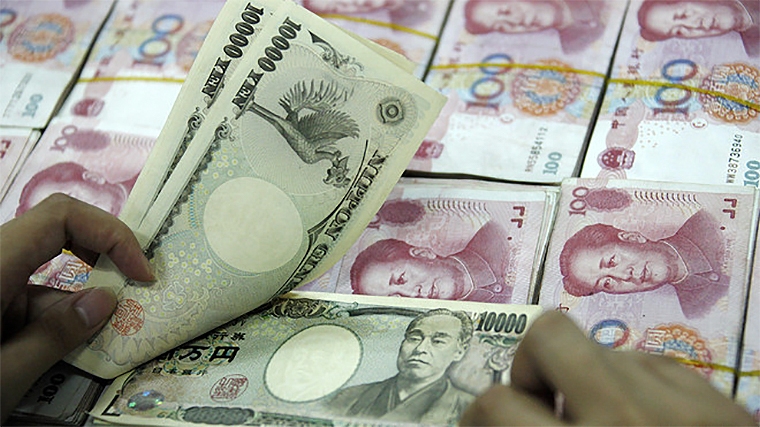
Ahead of a busy week, the USD weakened, about time following eight consecutive weekly increases in the DXY index. A stronger yuan, given the heavy hand of the PBoC and some supportive credit data, has spilled over into a stronger NZD, AUD, with the stronger yen also playing a role. US Treasuries show small net movements and a slightly steeper curve while equity markets are on a stronger footing.
Mondays are normally pretty dead but currency markets showed some life with a few key developments worth noting. The yen strengthened as soon as the NZ market opened yesterday following BoJ Governor Ueda’s comments reported in a weekend newspaper interview. Ueda said it’s possible the central bank will have enough information and data by the year-end to judge if wages will continue to rise, a condition for adjusting stimulus. He added that ending the BoJ’s negative interest rate is among the options available.
Ueda’s comments might well have been made to reduce selling pressure on the yen than encourage higher rates in the context of the very weak yen and data released on Friday showing much lower than expected wages inflation, but there was an impact on both markets. USD/JPY opened the week near 147 from the week-end close of 147.80 and traded below 146 later in the Asian session before settling at 146.50. Japan’s 10-year rate rose above 0.70%, for the first time since January 2014 without any sign of the BoJ using a handy hand to drive the rate back down.
Meanwhile, the yuan strengthened after the PBoC published the strongest ever CNY reference rate relative to market estimates, keeping CNY/JPY close to the key 20 mark. A few hours later, the PBoC backed that up with a statement saying that “participants of the FX market should voluntarily maintain a stable market and resolutely avoid behaviours that disturb market orders such as conducting speculative trades”. Later in the session there were reports of major Chinese banks selling USD/CNY aggressively.
USD/CNH was down below 7.30 by the NZ close after opening around 7.36 and yuan strength was largely sustained after China credit data were stronger than expected, following the slump in July. Stronger credit growth was supported by a rebound in mortgage and corporate loans. Broad credit growth ticked up from 8.9% y/y to 9.0% y/y, the first acceleration since March.
The NZD and AUD were well supported by that backdrop, with some broader USD weakness after its strong run thrown into the mix. In our weekly currency update we noted that the DXY relative strength index had, for the first time in year, breached the 70 mark, signalling a move into overbought territory. That is no longer the case, with the DXY index down 0.5%. The NZD is up 0.6% from last week’s close to 0.5920, while a slightly stronger gain for the AUD to 0.6430 sees NZD/AUD slightly lower at 0.92. The EUR and GBP show more modest gains, of about 0.4%, so those NZD crosses are slightly stronger. NZD/JPY is down 0.3% to 86.7.
Ahead of the ECB meeting later this week, the European Commission downgraded its growth projection for the euro area economy by three-tenths for 2023 and 2024 to to 0.8% and 1.4% respectively, dragged down by a contraction in Germany’s economy, with GDP falling 0.4% this year and only growing 1.1% next year. While the inflation projection for this year was downgraded slightly to 5.6%, it was upgraded slightly to 2.9% next year. Economists are evenly split on whether the ECB will hike by 25bps on Thursday night while the market is about 40% priced for a hike.
Compared to currencies, the bond market has been relatively quiet, with US Treasuries trading a narrow range and higher JGB yields imparting a modestly bearish pulse for longer term rate markets elsewhere. The US curve showed a small steepening bias, with the 2-year rate little changed and the 10-year rate up 2bps to 4.28, albeit down slightly from the level prevailing at the NZ close. Yesterday, global forces sent NZ rates higher across the curve, with NZGB yields up 4-6bps and swap rates up 5-8bps. The NZ 10-year government bond closed just under the 5% mark.
US equities are stronger, with the S&P500 up 0.7% and the Nasdaq index up 1.2%. Tesla is up close to 10% after Morgan Stanley said that Tesla’s Dojo supercomputer could add as much as $500b to the company’s market cap by opening up new addressable markets.
The domestic focus in the day ahead will be the pre-election economic and fiscal update due at 1pm. This wouldn’t ordinarily cause any NZD reaction but the accounts will show further deterioration in NZ’s fiscal accounts, highlighting NZ’s poor “twin deficits” situation. The rates market seems well prepared for NZDM to upscale the projected borrowing requirement. Ahead of the release, NZ card spending, migration and tourism data will be released. The key global release is the UK labour market reports tonight, which could be key ahead of the next BoE meeting.

We welcome your comments below. If you are not already registered, please register to comment
Remember we welcome robust, respectful and insightful debate. We don't welcome abusive or defamatory comments and will de-register those repeatedly making such comments. Our current comment policy is here.